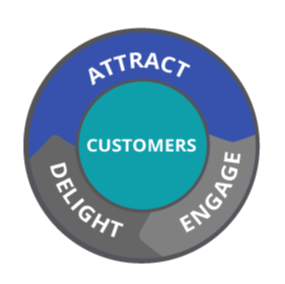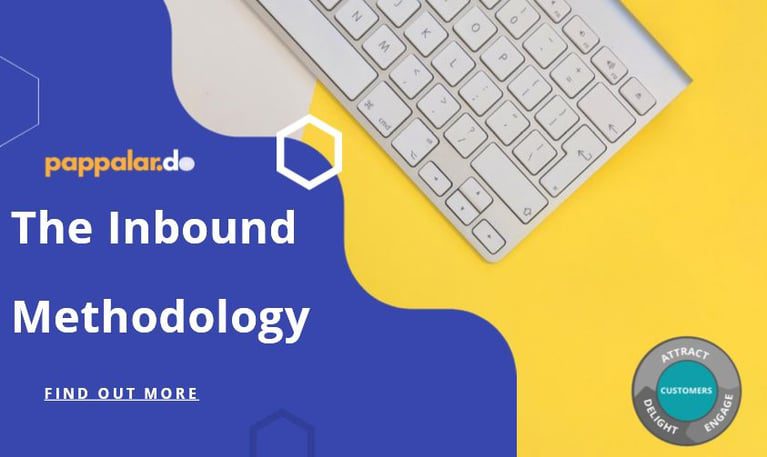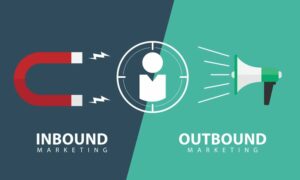You’re probably familiar with the concept of Inbound Marketing – we talk about it a lot here at Pappalardo Digital. The general idea is that when you keep your customers at the center of your business and focus on providing value, then everyone succeeds together. For those of you thinking that’s a little too “Pie in the sky”, let’s break down Inbound Marketing using the Inbound Methodology to gain an understanding of how inbound marketing works and how it can help your business grow.
What is the Inbound Methodology
The folks at HubSpot really get the credit for creating the Inbound Methodology. They wrote the book on Inbound Marketing – literally.
The Inbound Methodology has gone through a bunch of changes and iterations over the years, but the current iteration goes like this.
 You do a bunch of marketing stuff and sales stuff and customer service stuff, but whatever you’re doing, your customers and the customer experience should be at the center of it all. After all, it’s not so much what you sell – it’s how you sell it.
You do a bunch of marketing stuff and sales stuff and customer service stuff, but whatever you’re doing, your customers and the customer experience should be at the center of it all. After all, it’s not so much what you sell – it’s how you sell it.
Now that we’ve agreed on that – all of the actions that your company takes fall into one of three categories: you want to attract the right audience (marketing activities), engage and excite your prospects (sales activities), and delight your customers (customer service activities). As you do this, you’ll fill your marketing pipeline, you’ll sell more, and your customers will find more success with your products or services.
Removing friction from the flywheel
HubSpot goes on to say that your business should act like a flywheel, so as you’re attracting, engaging, and delighting your customers, you’ll gain momentum. The cool thing about flywheels is that you get them spinning, they will spin forever until friction is introduced.
So, as you’re doing a better job of attracting the right audience, engaging with leads and prospects at the right time with the right message, and delighting your customers so that they become promoters, your business’s flywheel will take off. Word of mouth will spread, your sales team will consult their way to a higher quantity and quality of deals, and your pipeline will fill up.
However, there’s one thing you must be aware of – friction! If it is hard for someone to buy from you, or if you don’t have a good handoff between your sales team and your customer service team, then it will slow down your flywheel. In other words, it will cost you customers – through a higher churn rate or through word of mouth. So, be very conscious of this as we move forward, and always be on the lookout for how you can make it easier for people to buy from you, easier for people to get their questions answered, and easier for them to pull out their credit card and pay you. The best inbound marketing strategy will fail if there is too much friction in your business.
The 3 Stages of the Inbound Methodology
The Attract Stage
 The Attract Stage is the first stage of the inbound methodology. During this stage, your focused on pulling in the right people with great content and conversations. You want to be seen as a leader and consultant that they can trust.
The Attract Stage is the first stage of the inbound methodology. During this stage, your focused on pulling in the right people with great content and conversations. You want to be seen as a leader and consultant that they can trust.
How to Attract the Right People
Most of the strategies around attracting the right audience revolve around content marketing. That’s going to be reaching people where they are – social media, search engines, forums, and so on. It’s also likely going to involve digital advertising, like Google Ads or Facebook Ads. The goal here is to consistently create and publish content and then publish it to your blog and to social media. The type of content you could write might be tutorials on how to use your product or service, information about how you can help with your reader’s pain points, customer testimonials, and promotional material like a discount or sale.
You’ll also want to create content offers. Content offers provide extra value and are usually given out for free in exchange for the person’s contact information.
You’ll want to get in the heads of how your ideal customers search for solutions to their pain point and optimize all of this content using an SEO strategy, so that your content organically begins to appear on the search engine results page when people are searching for information. This can be a crucial step in ramping up your inbound marketing campaign and a huge revenue stream for your business.
Quick sidenote: this process of getting into your customers heads is known as creating your buyer personas. We have a really great resource on creating personas for your business you might want to check out.
The Engage Stage
 Once you have a person’s contact information, you can begin engaging with them to offer solutions that align with both their pain points and their goals so that they are more likely to choose you when it is time to make a purchase.
Once you have a person’s contact information, you can begin engaging with them to offer solutions that align with both their pain points and their goals so that they are more likely to choose you when it is time to make a purchase.
How to Engage Meaningfully with Your Prospects
Once someone is in your pipeline, it can be really easy to get dollar signs in your eyes and turn into a pushy salesperson. Inbound is not about a short-term sale, it’s about building a long-term, mutually beneficial relationship with your prospects that leads to better deals. Take on the role of consultant and do the right thing – sometimes that’s saying that your products and services aren’t a good fit and you should both be okay with that.
During this stage, it’s important to have a strategy for how you handle both inbound and outbound sales calls. Make sure you’re selling a solution, and not just selling your product. For instance, I might sell marketing services as a product, but I’m selling business growth as a solution, and there’s a very real difference in those two.
During this stage, you may also look at how you handle sales documents, customer testimonials, and you may even want to conduct an audit of your entire sales process to make sure you’re focusing on what’s working best.
The Delight Stage
 The Delight Stage deals with how you provide support to your customers so that they find success with your product or service. The biggest friction point in a business is unhappy customers. This is an area that is often overlooked by businesses, but can be one of the biggest levers of growth.
The Delight Stage deals with how you provide support to your customers so that they find success with your product or service. The biggest friction point in a business is unhappy customers. This is an area that is often overlooked by businesses, but can be one of the biggest levers of growth.
How to Delight Your Customers
After a customer makes a purchase, it’s your job to ensure that they feel happy and supported, even after they’ve made a purchase. Your customer service strategy should focus on positioning your business as advisors in your customers success, and your support team should be solely focused on assisting customers in a delightful way.
Not all of this is about feel-good feelings and warm fuzzies. There’s a real business case to delighting your customers. First, you can decrease the demand on your customer service team by including chatbots at the right time to assist and support your customers when it looks like they’re running into an issue. You also send out automated surveys to request feedback and keep a pulse on your business.
In addition to chatbots, focus on setting up other types of self-help tools, like a Knowledge Base. Your customers will use these to quickly find answers to their questions without having to reach out to a member of your support team. Not only is this how most customers prefer to find answers to their questions, but it also reduces the strain on your support staff.
If you receive a poor survey result, it gives you the opportunity to make it right to your customer. Sometimes that is a simple, “I’m sorry, we’ll do better”, and sometimes it actually becomes a feature request for your product or service that helps you provide a better experience to all of your customers. Treat these as the opportunities that they are.
Finally, when you receive great reviews from your surveys, that’s an opportunity to really pour into that customer. Remember, a delighted customer becomes a promoter of your company, so don’t let these slip through your fingers.





